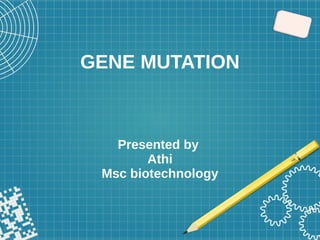
Mutation
- 1. GENE MUTATION Presented by Athi Msc biotechnology
- 2. Mutations are alterations in DNA sequences that result in changes in the structure of a gene. The process by which mutations is produced is called mutagenesis. General characteristics of mutation ● Mutation are generally recessive,but dominant mutations also occur ● Mutations are generally harmful to organism ● Mutation are random, occur at any time and in any cell ● Mutation are recurrent that is the same mutation may occur again and again
- 3. Causes of mutation ● Errors in DNA Replication On very, very rare occasions DNA polymerase will incorporate a noncomplementary base into the daughter strand. During the next round of replication the missincorporated base would lead to a mutation. This, however, is very rare as the exonuclease functions as a proofreading mechanism recognizing mismatched base pairs and excising them. ● Errors in DNA Recombination DNA often rearranges itself by a process called recombination which proceeds via a variety of mechanisms. Occasionally DNA is lost during replication leading to a mutation. ● Chemical Damage to DNA Many chemical mutagens, some exogenous, some man-made, some environmental, are capable of damaging DNA. Many chemotherapeutic drugs and intercalating agent drugs function by damaging DNA. ● Radiation Gamma rays, X-rays, even UV light can interact with compounds in the cell generating free radicals which cause chemical damage to DNA.
- 4. Types of mutation There are three types of DNA Mutations: base substitutions, deletions and insertions. ● 1. Base Substitutions Single base substitutions are called point mutations, recall the point mutation Glu -----> Val which causes sickle-cell disease. Point mutations are the most common type of mutation and there are two types. Transition: this occurs when a purine is substituted with another purine or when a pyrimidine is substituted with another pyrimidine. Transversion: when a purine is substituted for a pyrimidine or a pyrimidine replaces a purine. ● Point mutations that occur in DNA sequences encoding proteins are either silent, missense or nonsense. Silent: If abase substitution occurs in the third position of the codon there is a good chance that a synonymous codon will be generated. Thus the amino acid sequence encoded by the gene is not changed and the mutation is said to be silent. Missence: When base substitution results in the generation of a codon that specifies a different amino acid and hence leads to a different polypeptide sequence Nonsense: When a base substitution results in a stop codon ultimately truncating translation and most likely leading to a nonfunctional protein.
- 5. ● 2. Deletions A deletion, resulting in a frameshift, results when one or more base pairs are lost from the DNA (see Figure above). If one or two bases are deleted the translational frame is altered resulting in a garbled message and nonfunctional product. A deletion of three or more bases leave the reading frame intact. A deletion of one or more codons results in a protein missing one or more amino acids. This may be deleterious or not. ● 3. Insertions The insertion of additional base pairs may lead to frameshifts depending on whether or not multiples of three base pairs are inserted. Combinations of insertions and deletions leading to a variety of outcomes are also possible.
- 6. Mutagen Mutagens are chemical or physical agents that increases the occurrence of muation ● Radiation. Radiations were the first agents reported to be mutagenic. Ionizing and non-ionizing radiations, like UV rays, X-rays, alpha rays, and neutrons, have been found to exert mutagenic effects.Most of these radiations exert a lethal or Sub- lethal effect ● Base analogs. These agents possess structural similarities to the bases i.e., purines and pyrimidines. The most common base analogs which are considered as a chemical mutagen are – 5-Bromouracil and aminopurine. ● Intercalating agents. Intercalating agents are the molecules that have a hydrophobic heterocyclic ring structure and resemble the ring structure of base pairs. These agents place themselves in the DNA helix, which eventually interferes with the replication, translation, and transcription resulting in mutation, most commonly frameshift mutation. Ethidium bromide, proflavine, acridine orange, actinomycin D, or daunorubicin, etc are some of the common intercalating agents
- 7. ● Metal ions. Mineral ions like nickel, chromium, cobalt, cadmium, arsenic, chromium and iron, generate reactive oxygen species (ROS) that cause DNA hypermethylation, thereby promoting DNA damage and hindering the DNA repair process. ● Alkylating agents. These agents induce alkyl groups in DNA resulting in DNA damage. The introduction of the alkyl groups increases ionization that results in base-pairing errors and eventually inducing gaps in the DNA strand. Some of the common alkylating agents are ethylnitrosourea, mustard gas, vinyl chloride, Methylhydrazine, Busulfan, Carmustine, lomustine, Dimethyl sulfate, Temozolomide. ● Transposons and Insertion sequences (IS). They are units of DNA that undertake self-directed relocation/multiplication of the DNA fragment. The simplest type of transposons (~10-50 base pair long) are known as insertion sequences or IS. Both IS and transposon are also known as jumping genes as they move from throughout the DNA ● Viruses. Disruption of genetic function might be the result of the insertion of viral DNA into the genome. Certain viruses, e.g. Rous sarcoma virus, have been reported to induce cancer. Thus, it can be said, that viruses can be mutagenic. ● Bacteria. Certain inflammation-inducing bacteria like Helicobacter pylori produces reactive oxygen species that results in DNA damage and reduced DNA repair. This raises the likelihood of the mutation.
- 8. Thank you